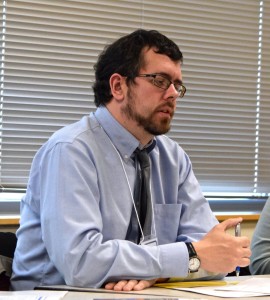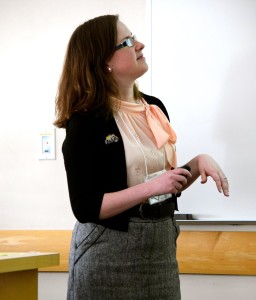Spring has sprung again, and again we trek to the Eastern American Studies Association’s annual conference. I’ve been attending since 2009 as a presenter (I also attended in 2005 or 2006 as an audience member), and I really love the mission of this particular group. It is student centered, with a unique focus on the work of undergraduate students. It houses an undergraduate journal (the only one of its kind in American studies), the first national American studies honors society (EAK, which I feel like has the same name as a fraternity in Monsters University), and an undergraduate roundtable, which has become so popular that it split into two separate panels last year.
I’m also honored to serve as the Graduate Student Representative on the executive board and as the interim regional representative to the American Studies Association (while our real rep is abroad). I dedicate serious thought and time to this conference (although not as much as last year, when I was a co-coordinator). Our theme was “Land and Sea,” and we joined with the Middle Atlantic Folklife Association (MAFA) to put together a really big event.
2015’s meeting was held at Rowan University in Glassboro, NJ over this past weekend (March 27 and 28, specifically). One of the pleasures of conference travel is the ability to do so with my graduate school friends, and this year was no exception. It was the usual suspects (Me, Becky, Andrea, Hilary, and Semontee) with the wonderful addition of this year’s co-coordinator, Christie. When you aren’t in coursework or teaching anymore, it is difficult to get to know the newer students, so it was nice to get to know her a little better. We got Starbucks, gabbed, laughed, panicked over our cars, and arrived at Rowan with little difficulty. I had no idea Rowan’s campus would be so large! It was really nice, and it looks like they are expanding and improving even further.
I attended the executive board meeting at noon in Hollybush, a historical home on Rowan’s campus. Aside from being an important Glassboro landmark, it is also the location of the Summit at Hollybush, which occurred in 1967. Because of its location half-way between Washington and NYC, it was chosen to host a meeting between President Lyndon Johnson and Soviet Premier Alexei Kosygin to discuss a release of tension during the Arab-Israeli Six Day War. Kosygin was in NYC to address the United Nations. The summit was successful and tensions were relieved on this topic. The executive board was fascinated by the history, and we even got to sit in the chairs that Johnson and Kosygin had once occupied. Here is Drs. Kupfer and Bronner squaring off:

The meeting was fruitful, and I was off to present at 2pm, the first session of the weekend. “Art and Animation: Reading the Land” was the title of our panel, and there were four very different presentations about New Jersey artists, Modern art and landscape, Donald Duck comics, and Walt Disney & Charles Willson Peale. The last one, perhaps obviously, was mine. I wish I had gotten more effective feedback and questions from the audience, but my moderator ended up being a great resource and new academic connection. She suggested investigating Woody Register’s Kid of Coney Island: Fred Thompson and the Rise of American Amusements. I plan on doing so this week. Thanks Elizabeth O’Connell-Gennari of Rowan University! My colleague, Peter Bryan, was a co-panelist, and I can’t wait to pick his brain more about his research. He and I frequently present together because of our mutual interest in Disney (albeit very different aspects of his work).


3:30’s “Roads, Rivers, & Racetracks: Americans on the Move” was not to be missed. I’ll admit: My sole motivation for attending this panel was the work of Ms. Hilary Miller, friend and fellow Downton Abbey watcher. Her dissertation work on the history of the National Road is really interesting, and her work in the archives pushes me to do more. She used National Road narratives to investigate how American identity was formed and perceived during the early 19th century. She was followed by another Penn Stater, Wes Stauffer, who has done great work in the field of World War II history, particularly here about the AlCan Highway. My dad is very interested in what one could call “historical logistics,” and that interest has rubbed off on me. Very cool stuff. Finally, Jonathan Silverman of UMass Lowell discussed his research on what has become of old horse-racing tracks, especially how he uses Google Maps to match the locations of old tracks with present day roads and developments. Many of them still exist in spirit as shopping centers, neighborhoods, and curved roads (mostly still possessing the theme of horses or racing). It was a whole new method that I had never considered!
I needed to rest after this (I hadn’t slept well the night before and driven quite a lot), so Hilary and I debriefed with our friend Lynne, who drove in for the day from her position as Director of the Arch Street Meetinghouse. Go visit her. Reconnecting with people is a major perk of conferences like these. If you would like to read about the plenary session, “The Child of Such Union: A Forum on the (Em)Bedding of Folklore and American Studies,” see John Price‘s post on the EASA conference.
The reception was lovely, and gave everyone a chance to regroup, have a beer, and catch up with old friends and mentors. We were warmly welcomed by members of the Rowan community, David Puglia (President of MAFA and a classmate of mine at PSH), and Nicholas Paleologos, the Executive Director of the New Jersey State Council on the Arts.
We checked in at the hotel, and while some of us were tapped out from the day, others socialized over a drink and some apps at the restaurant next door. It was a very long day for everyone, and I’m glad I was able to muster the energy to share that time with friends.
Saturday dawned cold and early. Cheesy, but true. After a quick breakfast of Froot Loops at the hotel (I’m totally an adult person), we jetted off to Rowan again for another three panels. For a re-cap of the 8am panel “Mass Media(ted): Mediation on Pop Culture,” see John Price‘s blog. Because we got to the morning panel late, I decided to wait and have some tea. At 9:30, I attended a symposium on American Studies and Teacher Preparation. I attended La Salle University, which requires its Elementary and Special Education majors to double major in American Studies. It makes them more marketable and provides them with a wide subject matter knowledge base. Despite these advantages, few schools that offer both majors connect them in such a way. Rowan University is another that makes the connection, and while it doesn’t require American Studies as the double major, it encourages it. Rowan’s studies have found that those who double major in AMST score higher on the Praxis II content test over all four subjects, and that American Studies-trained teachers better prepare their own students for standardized testing because it teaches them to think recursively. Former students of both programs spoke on the advantages it gave them, some less obvious than others, and we discussed as a group what the barriers were to improving these programs. I was totally re-invigorated after this panel, and it makes me excited for the day I can teach at La Salle again. My biggest challenge as a professor at La Salle was reaching the education students and making American Studies relevant to them.
Finally, I ended the morning supporting Becky Cecala and her research on the work on Dr. Josephine Baker. Her panel, “Gender Identities: Profession & Presentation” was diverse and fascinating. I was especially interested in Paulina Guerrero’s study of the Smith Island Crab Meat Co-Op. It was ethnographic research at its best.
The weekend was capped off with lunch, awards, and an interesting ride home. The GPS took us a different route than I was used to in coming from South Jersey, which we found out was to avoid traffic on I-76 in Philadelphia. We stopped at Wawa for smoothies, hoagies, and some snacks too. Anyone who knows me was probably wondering when that field trip happened. During the last leg of our trip, we experienced a pretty insane snow squall. It was difficult to see, and it was gone as quickly as it arrived. It was a dramatic ending to our weekend.
My thoughts on EASA are more well formed than last year. I have found myself “growing out” of certain conferences in the last few years. While fun, I really don’t see myself going to PCA/ACA anymore. I find that I get little effective feedback at the panels, and that networking is very difficult in my subject area. It also feels as though it is one person in a Batman costume away from being a very intelligent Comic-Con. I may also be outgrowing EASA as a presenter. I don’t get a lot of effective feedback, which is my major reason for presenting. Many of the attendees are other Penn State students, and they have already been my sounding boards. I have also found that too many projects come to EASA with no argument and no polish what-so-ever. It is a great place to start developing ideas, but one should at least come to the table with something. It may also be too friendly. I find that many audiences are reluctant to challenge a panelist in anyway. Yes, those challenges should come in a polite and collegial way, but we all need to be forced to defend our arguments. Others seemed straight-up unprepared or unaware of what presenting at a conference really entails.
That said, I want to continue to attend EASA as a board member. The academic climate is changing, and I think an association as small as EASA can more easily change with the times to stay strong and relevant. I hope to help steer it in that direction as a board member. It should continue to be about the free exchange of academic ideas, while also guiding students of all levels through their research and academic careers.

Essentially, EASA saves people from swimming through academia alone. I need to move from being a kid in the deep end to a lifeguard.
– The Lady Americanist.
PS: I hope to add more pictures later when the site cooperates. I think these are a nice taste of the weekend for now.